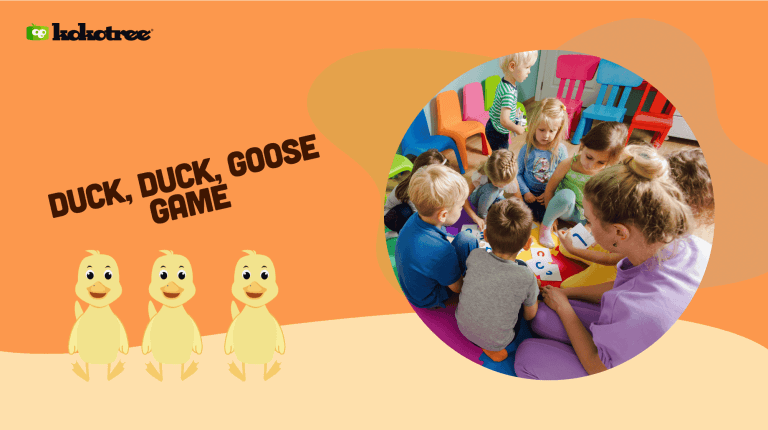

Written by: Kokotree
Last updated:

Duck, Duck, Goose is more than just a game—it’s a childhood rite. This classic playground pastime has taught kids about taking turns and enhancing their motor skills for generations. Beyond the giggles and fun, the game is a cognitive and physical development tool. Here’s your complete guide on bringing the timeless joy of Duck, Duck, Goose to your little ones.
The Duck, Duck, Goose game is a classic children’s activity where participants sit in a circle while one child walks around tapping others and saying “duck” until choosing a “goose.” The chosen “goose” must then chase and tag the first child before they sit down in the “goose’s” spot. The game is popular for teaching turn-taking and enhancing motor skills.
For ages 2-6. They watch and play for 20 minutes. You get a break.
⭐ 5,000+ parents get daily breaks with Kokotree.
Try it Free →Works in 30 seconds • No credit card • Cancel anytime
The primary aim of this game is to provide a structured yet entertaining way for kids to engage with each other. The game teaches children about taking turns, enhances motor skills, and introduces strategy and surprise.
See Also: The Hot Potato Game for more fun for your preschooler.
The Duck, Duck, Goose game isn’t just a fun pastime; it’s also a fantastic tool for a child’s development in various areas. Let’s take a closer look at the skills that can be nurtured through this classic game.
Speed & Agility: The core action in Duck, Duck, Goose involves running, which is excellent for improving a child’s speed and agility. The child selected as the “goose” must quickly jump up and chase the tapper, enhancing their reaction time and quick thinking on their feet.
Hand-Eye Coordination: As the “It” child goes around tapping heads, they practice their hand-eye coordination, which is critical for various other activities like writing, sports, and even simple daily tasks.
Muscle Development: The repeated running and sitting help to work out different muscle groups, from the legs to the core, contributing to overall physical health.
Decision Making: When the child, acting as “It,” decides who to designate as the “goose,” they engage in a level of strategic thinking. This helps develop their decision-making skills and problem-solving abilities.
Attention and Focus: The children sitting in the circle need to pay attention to whether they are being called a “duck” or a “goose,” enhancing their concentration skills.
Memory: Remembering who has already been a “goose” or “It” can add another layer of cognitive development, reinforcing memory skills.
Taking Turns: One of the most significant social benefits of Duck, Duck, Goose is learning the concept of taking turns. Each child waits patiently for their turn to be “It,” “duck,” or “goose,” teaching them patience and the importance of fairness in social interactions.
Teamwork: Although it seems like a straightforward game, the children are in essence working together to make the game fun and fair, reinforcing the concept of teamwork.
Communication: The simple act of saying “duck” or “goose” also encourages verbal communication. Plus, the subsequent laughter and cheering can be a great way to foster a joyful, communicative environment.
Emotional Intelligence: Understanding the disappointment of not being chosen as the “goose” or the excitement of the chase fosters emotional intelligence, helping kids learn to manage their feelings.
Conflict Resolution: On occasion, there may be disputes about whether the “goose” was tagged in time. This provides a natural opportunity to learn about resolving conflicts amicably.
Playing Duck, Duck, Goose is not just a way to pass the time; it’s a multifaceted learning experience. Teachers and parents who introduce this in their set of preschool games or toddler games are offering kids a wealth of developmental benefits.
Yes, as long as there is ample space and soft ground, like a carpet.
It is suitable for children as young as 3 years old, making it perfect for games for kids.
At least 4 players are ideal, but more make it merrier.
Absolutely, the game is fun for all ages!
Whether you’re a parent or a teacher, introducing Duck, Duck, Goose to your kids is like passing down a piece of cultural treasure. The laughter it brings and the skills it teaches are timeless. So gather your little ducks and let the game begin!



